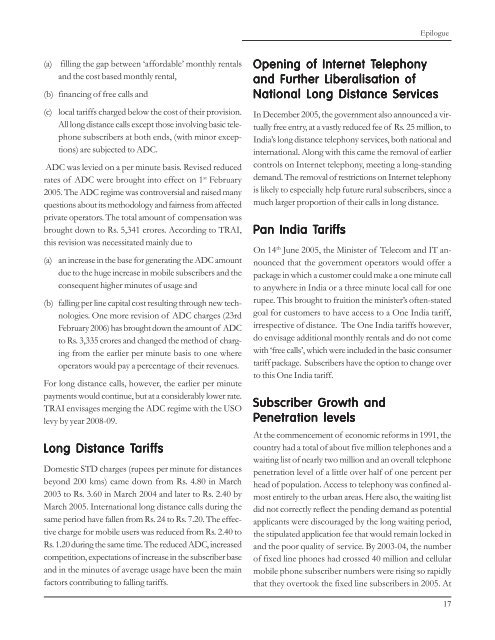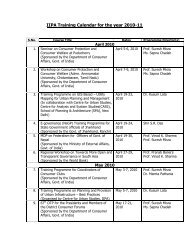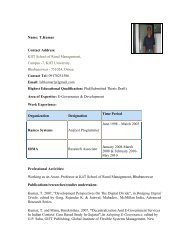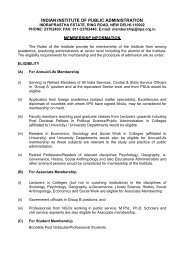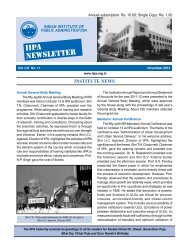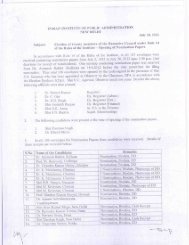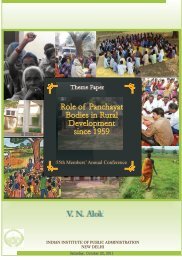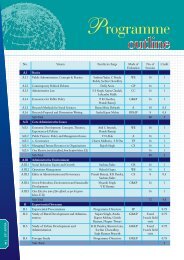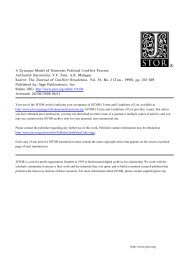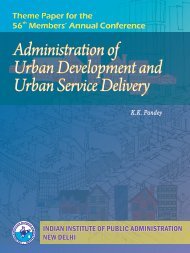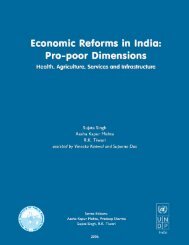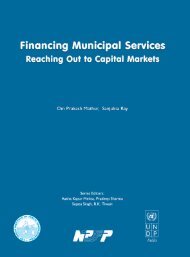India's Telecom Reform - Indian Institute of Public Administration
India's Telecom Reform - Indian Institute of Public Administration
India's Telecom Reform - Indian Institute of Public Administration
Create successful ePaper yourself
Turn your PDF publications into a flip-book with our unique Google optimized e-Paper software.
Epilogue<br />
(a) filling the gap between ‘affordable’ monthly rentals<br />
and the cost based monthly rental,<br />
(b) financing <strong>of</strong> free calls and<br />
(c) local tariffs charged below the cost <strong>of</strong> their provision.<br />
All long distance calls except those involving basic telephone<br />
subscribers at both ends, (with minor exceptions)<br />
are subjected to ADC.<br />
ADC was levied on a per minute basis. Revised reduced<br />
rates <strong>of</strong> ADC were brought into effect on 1 st February<br />
2005. The ADC regime was controversial and raised many<br />
questions about its methodology and fairness from affected<br />
private operators. The total amount <strong>of</strong> compensation was<br />
brought down to Rs. 5,341 crores. According to TRAI,<br />
this revision was necessitated mainly due to<br />
(a) an increase in the base for generating the ADC amount<br />
due to the huge increase in mobile subscribers and the<br />
consequent higher minutes <strong>of</strong> usage and<br />
(b) falling per line capital cost resulting through new technologies.<br />
One more revision <strong>of</strong> ADC charges (23rd<br />
February 2006) has brought down the amount <strong>of</strong> ADC<br />
to Rs. 3,335 crores and changed the method <strong>of</strong> charging<br />
from the earlier per minute basis to one where<br />
operators would pay a percentage <strong>of</strong> their revenues.<br />
For long distance calls, however, the earlier per minute<br />
payments would continue, but at a considerably lower rate.<br />
TRAI envisages merging the ADC regime with the USO<br />
levy by year 2008-09.<br />
Long Distance Tarif<br />
ariffs<br />
fs<br />
Domestic STD charges (rupees per minute for distances<br />
beyond 200 kms) came down from Rs. 4.80 in March<br />
2003 to Rs. 3.60 in March 2004 and later to Rs. 2.40 by<br />
March 2005. International long distance calls during the<br />
same period have fallen from Rs. 24 to Rs. 7.20. The effective<br />
charge for mobile users was reduced from Rs. 2.40 to<br />
Rs. 1.20 during the same time. The reduced ADC, increased<br />
competition, expectations <strong>of</strong> increase in the subscriber base<br />
and in the minutes <strong>of</strong> average usage have been the main<br />
factors contributing to falling tariffs.<br />
Opening <strong>of</strong> Internet net Telephony<br />
and Further Liberalisation <strong>of</strong><br />
National Long Distance Services<br />
In December 2005, the government also announced a virtually<br />
free entry, at a vastly reduced fee <strong>of</strong> Rs. 25 million, to<br />
India’s long distance telephony services, both national and<br />
international. Along with this came the removal <strong>of</strong> earlier<br />
controls on Internet telephony, meeting a long-standing<br />
demand. The removal <strong>of</strong> restrictions on Internet telephony<br />
is likely to especially help future rural subscribers, since a<br />
much larger proportion <strong>of</strong> their calls in long distance.<br />
Pan India Tarif<br />
ariffs<br />
fs<br />
On 14 th June 2005, the Minister <strong>of</strong> <strong>Telecom</strong> and IT announced<br />
that the government operators would <strong>of</strong>fer a<br />
package in which a customer could make a one minute call<br />
to anywhere in India or a three minute local call for one<br />
rupee. This brought to fruition the minister’s <strong>of</strong>ten-stated<br />
goal for customers to have access to a One India tariff,<br />
irrespective <strong>of</strong> distance. The One India tariffs however,<br />
do envisage additional monthly rentals and do not come<br />
with ‘free calls’, which were included in the basic consumer<br />
tariff package. Subscribers have the option to change over<br />
to this One India tariff.<br />
Subscriber Growth and<br />
Penetration levels<br />
At the commencement <strong>of</strong> economic reforms in 1991, the<br />
country had a total <strong>of</strong> about five million telephones and a<br />
waiting list <strong>of</strong> nearly two million and an overall telephone<br />
penetration level <strong>of</strong> a little over half <strong>of</strong> one percent per<br />
head <strong>of</strong> population. Access to telephony was confined almost<br />
entirely to the urban areas. Here also, the waiting list<br />
did not correctly reflect the pending demand as potential<br />
applicants were discouraged by the long waiting period,<br />
the stipulated application fee that would remain locked in<br />
and the poor quality <strong>of</strong> service. By 2003-04, the number<br />
<strong>of</strong> fixed line phones had crossed 40 million and cellular<br />
mobile phone subscriber numbers were rising so rapidly<br />
that they overtook the fixed line subscribers in 2005. At<br />
17


